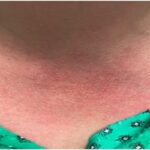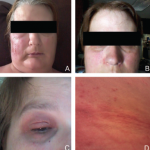Discussion
Systemic autoinflammatory diseases (SAIDs) have been categorized as a genetically heterogeneous group of rheumatic and inflammatory diseases over the past 20 years.25 This group of rheumatic disorders has undergone a rapid expansion, including, but not limited to, the hereditary periodic fever syndromes.26 These diseases are distinct from autoimmune diseases, such as systemic lupus erythematosus, rheumatoid arthritis and systemic vasculitis. The former group of disorders is often recurrent and possesses a constellation of fever, rash, arthralgias, abdominal and/or chest pain. More importantly, these diseases are usually devoid of detectable autoantibodies and are often associated with genetic markers/mutations.
SAIDs often share similar clinical phenotypes with one another, and they can mimic infectious, allergic, immunologic and autoimmune disorders, particularly in the early stage of disease, as in our case.27 Therefore, a broad differential diagnosis should be considered, including the new group of autoinflammatory disorders.
Classic SAIDs are often inherited in either autosomal recessive (FMF and HIDS) or dominant (CAPS and TRAPS) pattern, and thus, early onset of disease is common along with a positive family history, although late onset of these diseases can occur and present in an atypical or sporadic way. In the classic periodic fever syndromes, based upon our clinical experience and study, FMF, CAPS and TRAPs are clinically encountered in a decreasing order in the adult patient population, and adult onset of HIDS is extremely rare.28
The spectrum of NOD2-associated diseases has undergone an expansion over the past 10 years.29 NOD2 is a cytosolic innate immune sensor, which recognizes and responds to peptidoglycan contained within the cell wall of bacteria; it contributes to immune homeostasis.17
Crohn’s disease is associated with the three common loss-of-function NOD2 mutations, 1007fs, G908R and R702W, in up to 40% of cases, although the disease is also associated with variants in other multiple genes.30,31
BS is linked to the high-penetrant NOD2 variants in the central region. NOD and these NOD2 sequence variants include, but are not limited to, R334W, R334Q, E383K, E383G, G464W, L469F, W490L, M513R, R587C, T605N, H496L, M513T, C495Y and N670K, with R334W and R334Q being the most frequent variants.32 These variants represent gain of function.33
Since our initial description of the disease in 2011, YAOS has been reported in the U.S., Europe and Asia.6,34-37 To date, most cases have been reported in adulthood and are sporadic, without a clear pattern of inheritance. Disease onset can occur in children.
The pathogenesis of YAOS remains elusive. Our study has shown that NOD2 expression at transcriptional levels and pathway activation is abnormal in the disease. Specific NOD2 genotypes result in distinct NOD2 expression and cytokine profiles.38 In this disease, serum immunoglobulin levels can be low, and plasma levels of cytokines are normal as in this case.38,39
Other serum factors and adaptive immune responses have not been studied, although autoinflammatory disease is conceptually defined to mainly affect innate immune response. YAOS is considered to be polygenic; the interplay between the deficient NOD2 function, other innate immune sensor mutations and the environment is postulated to contribute to the disease. To prove this hypothesis, further study will be needed.
The disease is not uncommon; the incidence has been estimated at 1–10 cases per 100,000 people in the adult population.22
In conclusion, several important points are raised from this complex case analysis.

